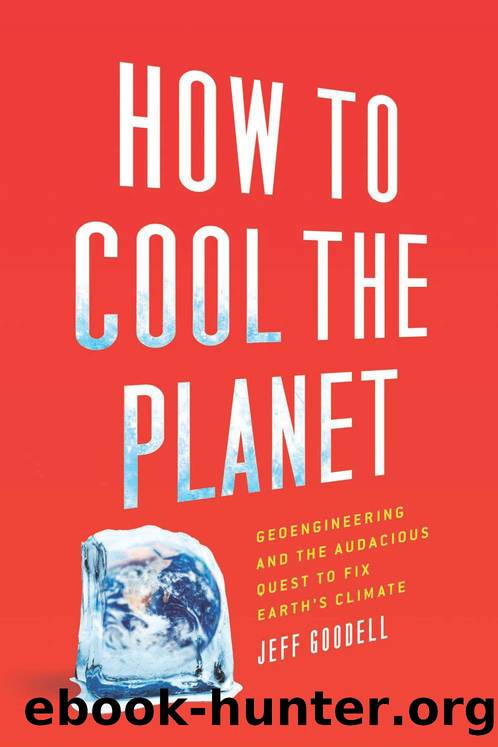How to Cool the Planet: Geoengineering and the Audacious Quest to Fix Earth's Climate by Jeff Goodell

Author:Jeff Goodell [Goodell, Jeff]
Language: eng
Format: epub
Tags: Technology & Engineering, Environmental, General, Science, Global Warming & Climate Change, Nature, Weather
ISBN: 9780547487137
Google: 5hAnBB-wmH4C
Amazon: 0547520239
Publisher: HMH
Published: 2010-04-14T23:00:00+00:00
7
A Little Cash on the Side
ONE OF THE MOST frequently cited objections to geoengineering is that the earthâs climate is just too complex for us to mess around with. âWeâre fiddling with a very complicated system, trying to counter the consequences of other large human influences, inadvertent ones, in that system,â said John Holdren, President Obamaâs science adviser. âAnd itâs a dicey business, because weâre doing it without a complete understanding of how the machinery works.â
Obviously, there is much truth to this, especially given the potential consequences of a mistake. (Oops, sorry, didnât mean to turn France into a desert!) But it is also true that messing with things we donât understand is what human beings do. Isaac Newton, confounded by the mysteries of white light, messed around with a prism and invented the modern science of optics. Thomas Edison messed around with electric current; today we have light bulbs, laptops, and a digital economy. Curiosity and exploration are what drive scientific discovery, and until the twentieth century, when scientists started fiddling with genetic structures and nanomaterials and atomic bombs, no one was too concerned that an aggressively inquisitive scientist was going to wreck the planet. Newton may have poisoned his brain by trying to smelt lead into gold, but that was his problem.
In the world of geoengineering, mistakesâeven if theyâre well-intentionedâare everyoneâs problem. Holdren is exactly right when he talks about geoengineering being dicey businessâbut it only becomes dicey when you move from talking about it and thinking about it to actually doing it. In this sense, itâs a little like robbing a bank. Itâs perfectly fine to sit home all day and draw up plans; itâs only when you walk up to the teller and actually pull out a gun that youâre asking for trouble.
Consider the notion that we can remove CO2 from the atmosphere by dumping iron into the oceans. As an idea, itâs pretty interesting. Just as we have deserts on land, we also have deserts in the seaânot because of a lack of water, of course, but because of a lack of nutrients (especially iron) that allow plants to grow. If you dump a few hundred tons of iron into the barren waters near Antarctica, itâs like pouring Miracle-Gro on your garden: suddenly, phytoplankton (the scientific term for the single-cell plants that live in the surface waters) are blooming everywhere. Like all plants, phytoplankton suck up CO2. In fact, phytoplankton are ruthlessly efficient little carbon-eating machines. Although they make up less than 1 percent of the photosynthetic life on earth, they are responsible for about half the CO2 that is pulled out of the atmosphere each year (the other half is pulled out by land plants). The phytoplankton use the carbon to build calcium carbonate shells. When the organisms die, they slowly drift down into the deep ocean, where the carbon is effectively trapped for hundreds to thousands of years. Some of them settle on the ocean floor, where their shells are eventually transformed into
Download
This site does not store any files on its server. We only index and link to content provided by other sites. Please contact the content providers to delete copyright contents if any and email us, we'll remove relevant links or contents immediately.
Man-made Catastrophes and Risk Information Concealment by Dmitry Chernov & Didier Sornette(5926)
The Revenge of Geography: What the Map Tells Us About Coming Conflicts and the Battle Against Fate by Kaplan Robert D(4038)
Zero Waste Home by Bea Johnson(3782)
COSMOS by Carl Sagan(3559)
Good by S. Walden(3491)
In a Sunburned Country by Bill Bryson(3486)
The Fate of Rome: Climate, Disease, and the End of an Empire (The Princeton History of the Ancient World) by Kyle Harper(3007)
A Wilder Time by William E. Glassley(2820)
Camino Island by John Grisham(2765)
The Ogre by Doug Scott(2635)
Organic Mushroom Farming and Mycoremediation by Tradd Cotter(2631)
Human Dynamics Research in Smart and Connected Communities by Shih-Lung Shaw & Daniel Sui(2466)
Energy Myths and Realities by Vaclav Smil(2441)
The Traveler's Gift by Andy Andrews(2414)
9781803241661-PYTHON FOR ARCGIS PRO by Unknown(2326)
Inside the Middle East by Avi Melamed(2306)
Birds of New Guinea by Pratt Thane K.; Beehler Bruce M.; Anderton John C(2226)
A History of Warfare by John Keegan(2187)
And the Band Played On by Randy Shilts(2133)
